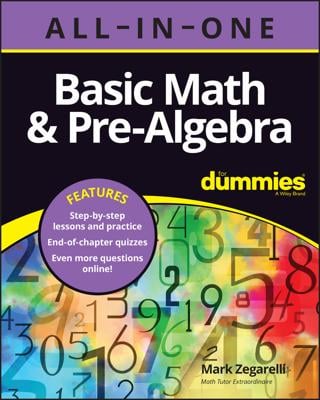Basic Math & Pre-Algebra All-in-One For Dummies (+ Chapter Quizzes Online)
Explore Book Buy On AmazonWhen an expression includes parentheses with only Big Four operators, just do the following:
-
Evaluate the contents of the parentheses.
-
Evaluate Big Four operators.
Sample questions
-
Evaluate (6 – 2) + (15 / 3).
9. Start by evaluating the contents of the first set of parentheses:
(6 – 2) + (15 / 3) = 4 + (15 / 3)
Move on to the next set of parentheses:
= 4 + 5
To finish up, evaluate the addition:
= 9
-
Evaluate (6 + 1) x (5 – (–14) / –7).
21. When a set of parentheses includes a mixed-operator expression, evaluate everything inside the parentheses according to the order of operations. Begin by evaluating the contents of the first set of parentheses: 6 + 1 = 7:
(6 + 1) x (5 – (–14) / –7) =
7 x (5 – (–14) / –7)
Move to the next set of parentheses. This set contains a mixed-operator expression, so start with the division: –14 / –7 = 2:
= 7 x (5 – 2)
Complete the contents of the parentheses by evaluating the subtraction: 5 – 2 = 3:
= 7 x 3
Finish up by evaluating the multiplication: 7 x 3 = 21.
Practice questions
-
Evaluate 4 x (3 + 4) – (16 / 2).
-
What’s (5 + –8 / 2) + (3 x 6)?
-
Find (4 + 12 / 6 x 7) – (3 + 8).
-
(2 x –5) – (10 – 7) x (13 + –8) = ?
-
4 x (3 + 4) – (16 / 2) = 20.
Start by evaluating what’s inside the first set of parentheses:
4 x (3 + 4) – (16 / 2)
= 4 x 7 – (16 / 2)
Next, evaluate the contents of the second set of parentheses:
4 x 7 – 8
Evaluate the multiplication and then the subtraction:
= 28 – 8 = 20
-
(5 + –8 / 2) + (3 x 6) = 19.
Inside the first set of parentheses, evaluate the division first and then the addition:
(5 + –8 / 2) + (3 x 6)
= (5 + –4) + (3 x 6)
= 1 + (3 x 6)
Next, evaluate the contents of the second set of parentheses:
= 1 + 18
Finish up by evaluating the addition:
1 + 18 = 19
-
(4 + 12 / 6 x 7) – (3 + 8) = 7.
Begin by focusing on the first set of parentheses, handling all multiplication and division from left to right:
(4 + 12 / 6 x 7) – (3 + 8)
= (4 + 2 x 7) – (3 + 8)
= (4 + 14) – (3 + 8)
Now do the addition inside the first set of parentheses:
= 18 – (3 + 8)
Next, evaluate the contents of the second set of parentheses:
= 18 – 11
Finish up by evaluating the subtraction:
18 – 11 = 7
-
(2 x –5) – (10 – 7) x (13 + –8) = –25.
Evaluate the first set of parentheses, then the second, and then the third:
(2 x –5) – (10 – 7) x (13 + –8)
= –10 – (10 – 7) x (13 + –8)
= –10 – 3 x (13 + –8)
= –10 – 3 x 5
Next, do multiplication and then finish up with the subtraction:
= –10 – 15 = –25

